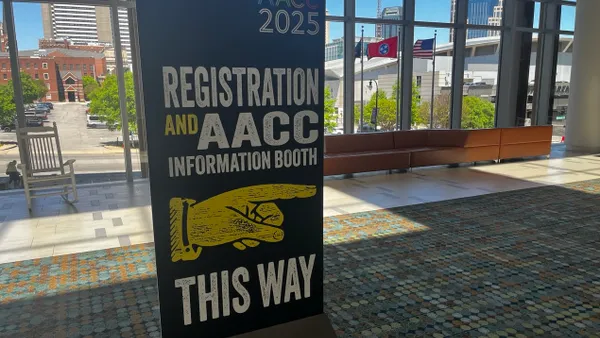Momentum is growing behind apprenticeships.
President Donald Trump signed an executive order in 2017 that called on the federal government to provide more apprenticeship opportunities. U.S. Education Department Secretary Betsy DeVos inked a deal last year with Swiss officials to encourage collaboration between the two countries on such programs. And just this year, the U.S. Department of Labor set aside $20 million to help community colleges train 16,000 apprentices over the course of the next few years.
Meanwhile, others have pointed to apprenticeships as a way to close the skills gap and avoid rising tuition prices.
Amid this environment, leaders from two-year institutions convened in a panel at the American Association of Community Colleges' annual conference, held in Orlando, Florida, to discuss how they have launched and run apprenticeship programs, and what they have learned along the way.
"Too many people are being left behind ... and they don't see a pathway forward," said Richard Rhodes, president of the Austin Community College District, in Texas. "The apprenticeship program, frankly, is one of the great opportunities for us, as colleges bridge that gap between the needs of individuals and the needs of our employers."
Engage employers
Harper College, in Illinois, has emerged as an innovator in its approach to apprenticeships. With the help of a $2.5 million federal grant from the Labor Department, the college has formed relationships with 44 companies to offer apprenticeships in traditional fields such as advanced manufacturing as well as jobs like cybersecurity, banking and finance, and insurance.
Rebecca Lake, the college's dean of workforce and economic development, said it is essential for institutions to find out regional companies' skills needs. "Apprenticeship programs are becoming nontraditional," she said. "They're not really in the trades anymore, (and) there's a lot of them we haven't even thought of yet."
However, a college's offerings may not always line up with what a company requests for an apprenticeship program. Even in those instances, institutions shouldn't back down, Lake said. For instance, if a company wants an automotive apprenticeship but a college can't support it, the institution could counter with a proposal for another apprenticeship in an applicable and in-demand field, such as supply chain.
Developing the strong relationships necessary to launch these programs requires persistence. "You have to have boots on the ground," Lake said. "If you think one (person) can go out and meet with every company that might be potentially interested, then you will be here forever and have a very poor program."
Keep curriculum current
Ingalls Shipbuilding, which says it is Mississippi's largest manufacturing employer, runs one of the oldest apprenticeship programs in the state. Through a partnership with Mississippi Gulf Coast Community College, about 800 students each year receive on-the-job training and in-class instruction across more than a dozen craft areas — including painting, welding and rigging — that they can roll into 30 semester hours toward a degree. So far, more than 4,000 students have graduated from the program, said Gulf Coast President Mary Graham.
Keeping the curriculum current can be a challenge. "If you don't have your foot on the accelerator, then you're backing up," she said.
To do so, Gulf Coast keeps in constant contact with its industry partners to assess what skills they want their workers to have now, as well as to help predict what workforce needs they'll have in the future.
"To avoid failure, have the crucial conversations with the industries you're trying to serve," Graham said. "Really try to define outcomes and what their expectations are for success."
Recently, the college revised its apprenticeship curriculum around these ideas, Graham said. It also launched a pre-apprenticeship program after leaders noticed many students didn't have the basic skills necessary to enter the full program.
Treat apprenticeships like a business
Once a college establishes apprenticeships, it will need to put "money and some effort" behind the programs in order to bring them to scale, Harper College's Lake said. "You can't just get the exact amount of money that will cover tuition because you will never be able to grow and sustain (the program)," she added.
Yet community colleges across the U.S. are strapped for resources after years of budget cuts and enrollment declines. To combat those challenges, panelists said they may have to reallocate resources or seek new partnerships and grants.
"We're not a for-profit, but we have to act like a for-profit in the background," Graham said. At Gulf Coast, that has meant the college has had to look for additional revenue streams by renting out facilities and throwing fundraising galas.
"We have to act like a for-profit in the background."

Mary Graham
President, Mississippi Gulf Coast Community College
It also pushed the college to make tough choices about which programs to keep and which ones to cut. Now, the leadership looks at every program annually to assess if it still helps graduates land jobs.
"That was a new concept a few years ago," Graham said. "No one wanted to hurt anyone's feelings, didn’t want to pull that program because 'Joe' had worked there for a long time — 'Joe' had to go at some point."
She continued: "It sounds harsh, (but) you have to be fast and aggressive. You have to be efficient with a few dollars."














